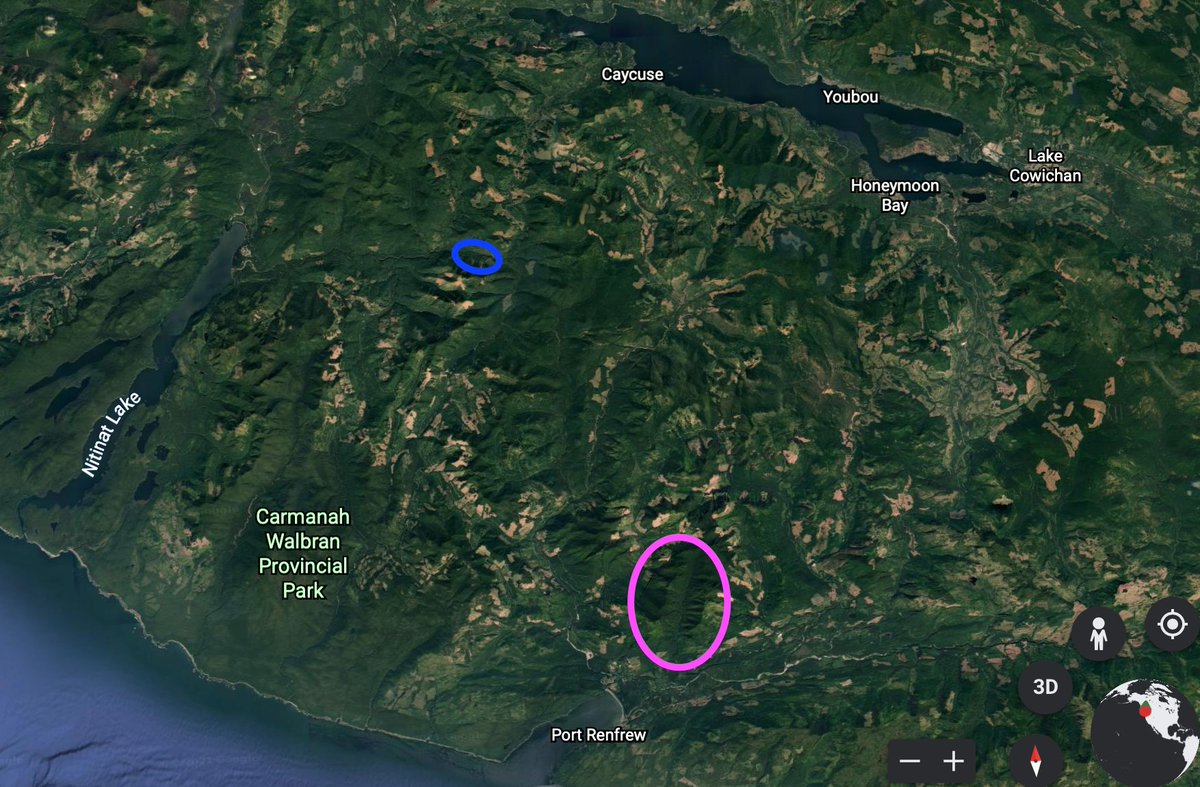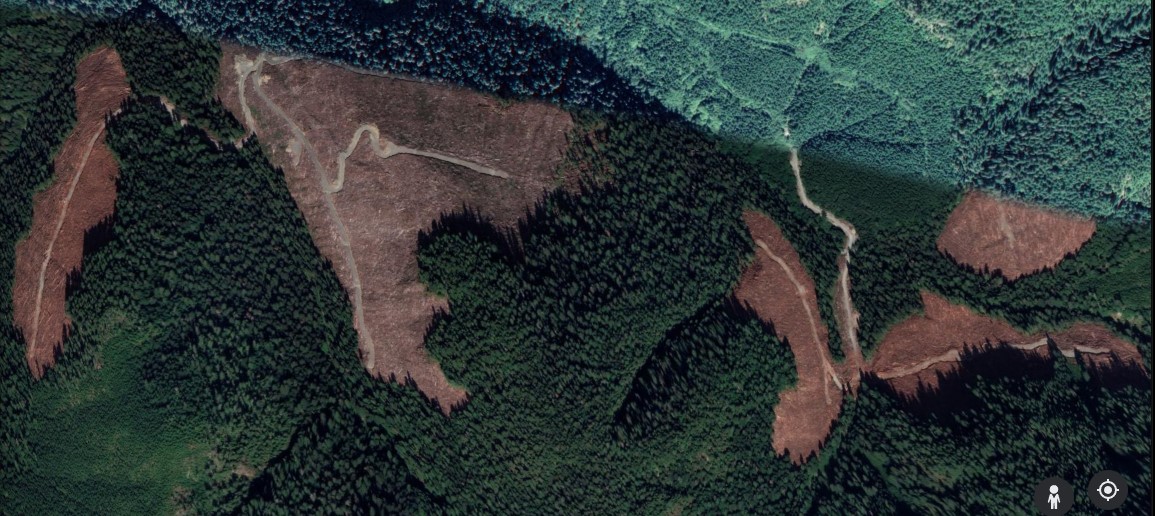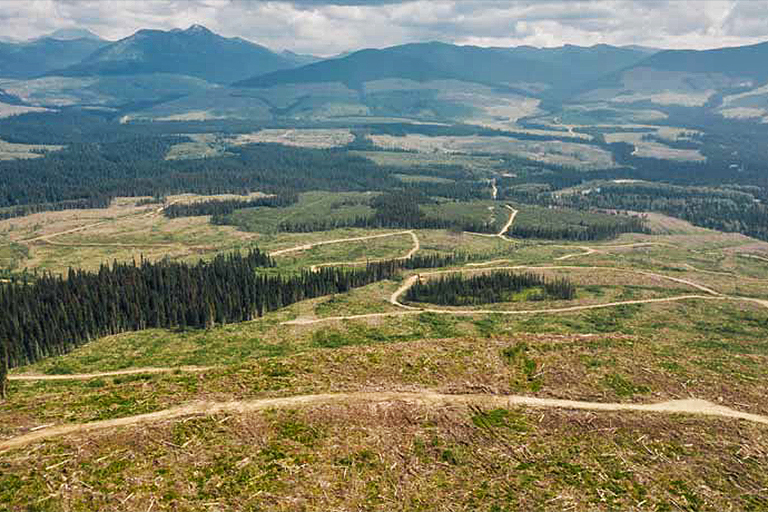- Two years after British Columbia’s majority party promised a logging “paradigm shift” to conserve what’s left of the province’s tall old growth forests, Mongabay observed dramatic clear cutting on Vancouver Island in forests slated for protection. Old growth harvesting continues across British Columbia (BC) today.
- The BC minister of land management told Mongabay that the government, in partnership with First Nations, has deferred logging on 1.7 million hectares of old growth forests. But critics contest those numbers and note that much of these deferrals are for scubby alpine forests that aren’t in danger of being logged.
- First Nation leaders have been tasked by the government to determine which old growth forests to protect. This presents Indigenous communities with an economic conundrum, as many tribes will lose much-needed logging revenue if they choose conservation.
- Today, BC has many second-growth tree plantations that give the appearance of vast wooded expanses. But as Mongabay observed in July, these tree farms are “ecological deserts” that store less carbon than tall tree old growth and harbor little biodiversity as BC experiences intensifying climate impacts partly due to decades of overlogging.
VANCOUVER ISLAND, BRITISH COLUMBIA — We drive for hours on rutted, gravel-strewn logging roads of this Pacific Coast island’s unpopulated southern outback. Trucks loaded with freshly cut red cedar and hemlock rumble past us in clouds of dust.
Finally, we arrive at a cut block in the Upper Caycuse Valley. It’s one of many watersheds here that once towered with ancient trees shading biodiverse ecosystems. Some were cut decades ago. This 10-hectare block was cut last year. More old growth trees — critical carbon sinks 250 years and older — will fall soon.
Steep ridgelines remain forested, but much of the rest of this formerly lush, rare coastal rainforest is decimated. What’s left: jagged stumps, roughed-in dirt roads, eroded runoff gullies and haystack-high slash piles of tangled limbs and roots waiting to be burned. It feels like a war zone; a crime scene.
“It’s hard coming back here. This is my second time since it was cut; I had to steel myself to see this,” says Torrance Coste, my guide on this July day and a forest advocate with the British Columbian environmental group Wilderness Committee.

Coste climbs atop a splintered cedar stump wider than his truck. He counts the rings, stopping at around 500 — a now missing giant that was already 270 years old when in 1792, Britain’s Captain James Cook first explored this island, the largest on North America’s Pacific Coast.
This block — and much larger, older forest blocks farther down the valley — were officially recognized in 2020 by the British Columbia (BC) government as at-risk old-growth forests that should have all been off limits to logging. But the designation, and protections, have yet to come — delayed by an administration that promised to act to conserve the trees.
Teal Jones Group, a 70-year-old family-owned logging company, keeps rushing to cut these last remaining tall old-growth trees on southern Vancouver Island while it can. A Teal Jones spokesperson declined to be interviewed. The company maintains it adheres to the province’s standards for sustainable forest management.
It’s clear, as I observe miles and miles of land within one harvest area, that a logging company’s definition of sustainable differs greatly from that of people like Torrance Coste.
“I know the best old growth was logged long before I was born,” says Coste, 32. “We talk about leaving what’s left to future generations. But they’re taking it all. I wish every [BC] policymaker and politician could stand where we are — stood here before and stand here after. And then defend what’s still happening.”


Preservation ‘paradigm shift’ in waiting
Logging is proudly embedded in British Columbia’s history, economy and culture. But aggressive province-wide overlogging in the past 75 years, ecologists say, has contributed to hotter summer temperatures, flooding, landslides, wildfires and tree-killing insect infestations.
The result: The remaining badly fragmented forests in a province four times larger than California now emit more heat-trapping carbon dioxide than they sequester due mostly to widespread deforestation and wildfires — even with regular tree replanting, according to government research.
And the cutting continues apace, despite the BC’s majority government — the centrist New Democratic Party (NDP) — September 2020 pledge of an historic “paradigm shift” on behalf of old growth forests. Logging would still be supported, the administration said, but nature would finally take priority more often.
At the time, the NDP accepted in its entirety the Old Growth Strategic Review, a land-use plan created by BC foresters Garry Merkel and Al Gorley. That detailed review explains why and how to preserve the province’s remaining coastal and interior primary and old-growth forests and rare inland temperate rainforests.

Critically, the NDP agreed to the report’s 14 report recommendations, including a two-year deferral of logging “in old forests where ecosystems are at very high or near-term risk of irreversible biodiversity loss.”
But the elation of forest conservationists, felt two years ago when Premier John Horgan hailed the game-changing Merkel-Gorley report, has long faded. These critics concede, agreeing with NDP officials, that some old growth, in patches across the province, has been protected — places like the much publicized 1,200-hectare Fairy Creek. That rare jewel attracted international attention in 2021 when more than 1,000 protesters were arrested as they tried to stop logging in and near that rainforest.
The Upper Caycuse Valley, which I visited in mid-July, is just 18 miles from Fairy Creek. It and other old growth forests across the province have not been so lucky; giant trees in irreplaceable ecosystems are falling as the NDP stalls on implementing and enforcing deferrals. In fact, it appears to critics that the forestry industry is using the Old Growth Strategic Review as its guide for where to cut while government delays continue.
In an interview behind the grand campus of the BC legislature in Victoria, Sonia Furstenau, leader of the two-member Green Party, is among those impatient with unkept NDP promises.
“How is it in 2022 we’re still allowing clearcutting?” Furstenau asks. “This government says they are going to protect old growth. They say they are going to protect biodiversity. And then they don’t do it. I’m tired of them acting like a communications machine when we have this level of climate crisis.”


Top image shows dense old growth forests in 2020. Bottom image shows clear-cut blocks from 2021 and 2022. The big cut block on the left Mongabay viewed in July from across the valley. The smaller cut blocks on the right Mongabay walked through. This area was all designated by the BC government for logging deferrals in 2020 that have still not been implemented by the NDP. Old growth logging continues, as Mongabay witnessed this summer. Images by Torrance Coste, Wilderness Committee.
‘Managing old growth’
Josie Osborne is the NDP’s minister of Land, Water and Resource Stewardship, appointed in February. She agreed to answer Mongabay’s questions in writing. She emphasizes that “our government” remains committed to the paradigm shift recommended by Merkel-Gorley. “This shift is about more than protection,” she wrote. “It’s about managing old growth forests in a manner identified across all 14 recommendations.”
“This spring, our government, in partnership with First Nations [BC’s Indigenous peoples], deferred harvest of nearly 1.7 million hectares of old growth,” Osborne claimed, though critics dispute those numbers. “These unprecedented deferrals are providing the time and space we need to work together to develop a new, more sustainable way to manage BC’s forests. It is important to note that because of this work, 80% of most at-risk old growth is not threatened by logging.”
Osborne emphasized the NDP’s determination “to partner with First Nations [there are 204 in BC] to give local communities and stakeholders a bigger role in forest management decisions that affect them.”
Regarding the powerful timber industry and its ongoing clearcutting, she wrote: “We believe we can find a balance that prioritizes the health of forests, as well as logging practices that support people and communities.”
NDP critics say they believe Osborne will try harder than other government leaders to meet the majority’s conservation promises. But Mike Morris, a legislator in BC’s minority Liberal Party, questions to what end.
“I think we’re getting to the point where it doesn’t matter what position government takes; it’s too late,” says Morris, a woodsman and trapper from Prince George in BC’s vast interior. “Given 75 years of logging, there are very few old growth forests left. I just look in my area. I would say we’ve harvested 90% of the harvestable trees around Prince George, which is the largest timber supply in the province.”

How much old growth is really protected?
In BC’s old growth battle, widely diverging numbers are deployed as shields by NDP in its own defense, or as accusatory weapons by forest advocates.
Karen Price is a forest ecologist who, along with ecologists Dave Daust and Rachel Holt, are numbers experts. They specialize in estimating the remaining amount of BC’s most ecologically vital old-growth forests — towering Douglas fir, western red cedar and hemlock providing enormous carbon sinks crucial to slowing climate change and teeming with rare, biodiverse flora and fauna.
These trees, dubbed by Price “the white rhinos of old-growth forests,” are coveted most by timber companies because of their always-mounting economic value for a range of wood products such as construction material, flooring, shingles, even fine acoustic guitars.
In 2020, the NDP released optimistic estimates claiming that of BC’s 57.2 million hectares (221,000) square miles) of forest, some 23% (13.2 million hectares, or 51,000 square miles) of what was still standing was old growth.
Using that same data, Price, Daust and Holt distinguished vulnerable, tall old growth in rich ecosystems from stunted, sparse old growth on rocky, alpine mountainsides and forest bogs in unproductive ecosystems. Their findings were alarming: Less than 1% of big treed old growth remained in BC as of two years ago, or roughly 400,000 hectares (1,544 square miles) scattered in ecosystem fragments along the province’s coast and interior.
Given the delayed NDP logging deferrals, Price says, now even less is standing.
The ecologists’ widely reported findings were assaulted by forest industry defenders: “We are still dealing with personal attacks and letters calling our work into question,” she told Mongabay.

Price served last year on BC’s Old Growth Technical Advisory Panel. She credits the NDP with pushing logging companies to do more “partial harvests,” where a third of a cut block remains, as opposed to total clearcutting. But while her panel recommended 2.6 million hectares (10,000 square miles) of at-risk old growth be protected, the NDP agreed to well less than half that, 1.05 million hectares (4,054 square miles), some of which is already inaccessible to logging.
And even though that may still sound like a lot, she says, the new temporary protections are spread out in small blocks across the vast province. This does little to protect intact ecosystems, Price says, and also diminishes its climate-mitigation capacity.
“I’ll give them credit for new deferrals,” Price concedes, “but it’s really limited. What I see as a difficult part of the challenge is something like 750,000 hectares (2,900 square miles) we asked for [conservation] that are not deferred, that are our best remaining big-treed old growth, and that are in the timber harvesting land base.”
Mike Morris, the Liberal Party woodsman, criticizes the NDP approach: “Here’s the problem with this entire managed forest strategy. It’s only managed for one value, and that’s the tree. Not the wildlife, not the plant life, not the elk and salmon and streams. Not recreational value. Nothing else other than the tree itself. That’s not the nature-first paradigm shift they promised.”

A Catch-22 for First Nations
Shrewdly, critics say, the NDP shifted the decision regarding the fate of much of BC’s remaining tall old growth, including those critically important 750,000 hectares, to First Nations. Indigenous leaders across BC have been tasked with deciding how much of those forests they want protected and how much can be logged.
Here’s the catch: of BC’s 204 First Nation tribes, many are dependent on logging revenue derived from their lands. Choosing conservation means money forever lost to support their people. When Mongabay asked land management Minister Osborne if the NDP would compensate tribes for lost logging revenue, she did not answer the question.
“We are committed to working in partnership with First Nations to build a co-managed resource management system,” Osborne wrote.
In a June resolution regarding old growth deferrals, the Union of BC Indian Chiefs was more direct: “The province has failed to provide adequate funding or resources to First Nations to identify and implement areas for immediate logging deferral and resilience planning… Evidence indicates that logging companies continue to target old growth forests [in] proposed old growth deferral areas.”

Adam Olsen is a member of the Tsartlip First Nation. He lived on Vancouver Island reservations much of his life, so he and his family know firsthand about the harsh treatment of Indigenous people by the Canadian government for generations. Today, a Green Party member, he is one of just three Indigenous people sitting in BC’s 87-seat legislature.
While he appreciates NDP’s talk of reconciliation of land rights with First Nations, and also its willingness for ongoing engagement, Olsen decries what he calls “imbalanced negotiations” over pending old growth deferrals.
For ages, Olsen explains, Indigenous people “have been legislated into poverty.” Now that they have an opportunity to control their land, they must shift scarce financial resources away from social services, health care and education to pay legal fees to determine how much of their forests should be protected. It is, Olsen says, a slow, complex process.
“The longer these negotiations take,” Olsen says, “the more logging is taking place. It’s gross. It’s of no benefit to the government for these negotiations to go quickly.”

Political reality vs. Earth reality
Mike Morris calls himself an environmental “outlier” in a Liberal Party that adheres to traditional conservative ideology. That means when business interests are pitted against conservation, business wins. That’s a global reality, not unique to BC, he adds.
Undaunted, Morris is preparing a slideshow illustrating the graphic reality of BC old growth clearcutting to share with legislators. He notes that two out of three British Columbians live on a sliver of coastal land lying between Vancouver and Victoria. They’ve never seen BC’s interior or northern reaches, he says.
“People don’t understand what we have or how much we’ve lost,” Morris explains. “When I look at Google Earth and do some rough calculations, I can see that 75% to 100% of every watershed in the province has been clearcut. It’s had a devastating impact on animals and fish and so much biodiversity.”
Still, much of BC looks forested — from a distance. That’s because logging companies replant clearcuts with monocultures; single-tree species for future industrial harvests. Close up, things look very different. In mid-July, I walked into a 50-year-old Douglas fir farm. I was stunned at the sterile, midday darkness created by a roof-like canopy of trees all planted at the same time and of exactly the same height. There was little understory and no nature sounds.
“Second-growth tree farms are ecological deserts. They are unconnected from nature and will not recover as biodiverse forests in our lifetime,” Price says. “People don’t understand the value of big treed forests. They don’t understand that this is the heart of our province, the circulatory system of every watershed. They matter to the world. This is our best hope for climate mitigation. We have to keep them standing.”

British Columbia’s leading forest ecologist Suzanne Simard — who popularized the science that natural forests communicate through underground fungal networks — concluded in a 2020 study that BC old growth clearcutting dramatically undermines above ground carbon and soil carbon stores.
“Corporate lobbyists espouse that replacing old-growth forests with new plantations — [planting] trillions of new seedlings — will sequester and store more carbon. This is simply not true,” Simard wrote in The Globe and Mail, Canada’s most widely read newspaper. “Half of the carbon stored is lost to the atmosphere almost immediately with clearcutting of old forests, and it takes decades to achieve carbon neutrality, and decades more to recover the [carbon] sink strength of the original conifer stands.”
With BC’s domed legislative building looming in the background, Sonia Furstenau, the Green Party leader, tells me that despite her weariness with policymakers unaware of the province’s embattled landscape, climate change is too grave an issue for her to stop demanding the promised paradigm shift.
“Certain politicians say, ‘Canada is just 1% of global emissions; it doesn’t matter what we do,’” she says. “But if we protect our at-risk old growth, we can be 10% of the global solution. Why don’t we want to be the beacon of what’s possible? Wouldn’t that be nice?”
Banner image: Torrance Coste stands on a stump amid timbered old-growth cedar in the Upper Caycuse Valley. Image by Justin Catanoso.
Justin Catanoso, a regular Mongabay contributor, is a professor of journalism at Wake Forest University in North Carolina. Follow him on Twitter @jcatanoso
FEEDBACK: Use this form to send a message to the author of this post. If you want to post a public comment, you can do that at the bottom of the page.
